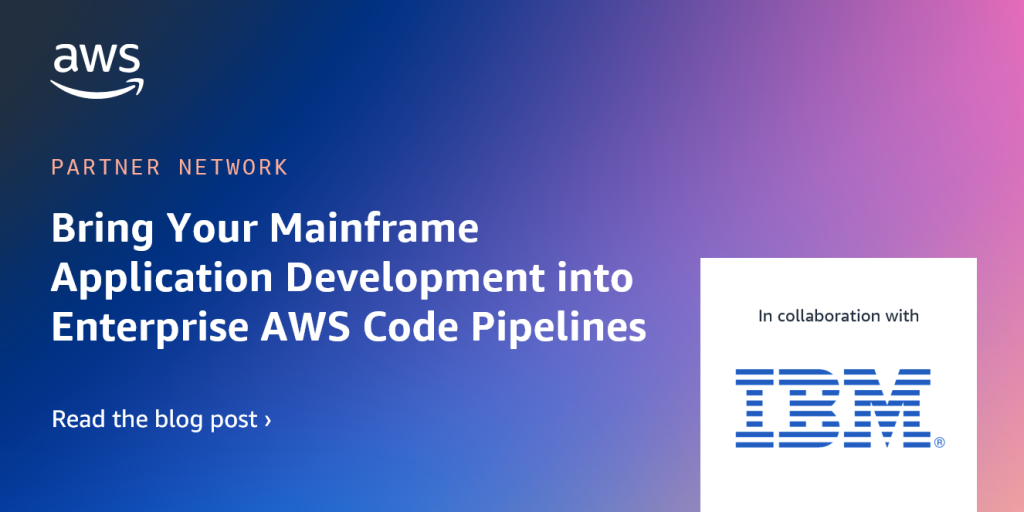AWS Partner Network (APN) Blog
Category: Developer Tools
Continuous Compliance at Scale in AWS CI/CD Pipelines Using Pulumi CrossGuard
To ensure cloud infrastructure is compliant with organizational policies and regulatory requirements, many platform engineering teams are embedding the policy-as-code practice into their DevSecOps toolchain. Learn how to use Pulumi and its CrossGuard policy-as-code feature to ensure your infrastructure is compliant before it’s ever provisioned in AWS. We’ll also demonstrate how to define custom policies in Python, and how to create a reusable package of policies by storing them in AWS CodeArtifact.
DXC Technology Enables End-to-End Tracing for Microservice Architecture Using AWS X-Ray
When a DXC Technology customer wanted a complete view of requests traveling through an application so they could compare trace sets with different conditions, DXC deployed distributed tracing using AWS X-Ray. This helped monitor and debug distributed applications within the workflow to aid in swift identification of performance issues or errors. Explore the solution’s reference architecture and follow a step-by-step how to enable AWS X-Ray for different AWS products.
Securing Your Infrastructure as Code Deployments with AWS and Snyk
When you combine AWS CodeBuild with Snyk to deploy your infrastructure as code project, you gain a repeatable process that’s easy to track and manage that happens to include security results. AWS provides the automation while Snyk provides enhanced security. Learn how to manage an IaC project written with Terraform by HashiCorp and deployed with AWS CodeBuild, and review results before a scan and after when hidden issues are often revealed.
Best Practices from Innovative Solutions for Migrating Databases in AWS Amplify Deployments
Learn how to implement database software development lifecycle (SDLC) automation when leveraging the AWS Amplify framework to quickly create a three-tier web application following cloud engineering best practices. This approach from AWS Premier Partner Innovative Solutions leverages the AWS Code suite coupled with the Amplify CLI to integrate database migrations against an Aurora Serverless V1 PostgreSQL cluster with deployment of an Amplify project.
Create Dynamic Serverless Applications with Neo4j Graph Database and AWS Lambda
The AWS Cloud Development Kit (AWS CDK) is a framework that provides an automated and repeatable way of handling cloud infrastructure. Learn how to use the AWS CDK to build an AWS Lambda function in Java that connects to Neo4j. The framework described here can be used to build dynamic serverless applications where the frontend scales based on system demand. This makes it possible to easily get value from your connected graph data in front end applications.
Bring Your Mainframe Application Development into Your Enterprise AWS Code Pipelines
IBM Z and Cloud Modernization Stack on AWS provide a cloud-native experience to modernize development practices, helping developers adopt a unified set of tools and DevOps methodology. Learn how the Wazi components available in IBM Z and Cloud Modernization Stack provide modern experiences for analyzing, developing, and testing mainframe applications in an isolated way, implementing the DevOps philosophy for developers to gain speed and flexibility.
A Low-Code, No-Code Platform Approach from Virtusa for App Modernization and Engineering Optimization on AWS
One of the key objectives of any transformation program is to find a novel way to achieve results in the shortest possible time, with speed and accuracy. Virtusa has been doing lot of work in the automation-led transformation space and has collaborated with AWS to help realize business benefits for customers across globe. Explore Virtusa’s perspectives on the low-code/no-code approach and walk through a homegrown solution framework.
Build and Deploy a Secure Container Image with AWS and Snyk
Learn how to build a Java application in a Docker container and push the container image to Amazon ECR orchestrated by AWS CodePipeline. We’ll use Snyk to scan your code, build a container image, and display the results in both Snyk and Amazon ECR. We’ll also show you how Amazon Inspector utilizes Snyk open source to provide insight into your software security vulnerabilities. All of this functionality is available from the AWS Management Console.
Building a Multi-Region Solution for Auto Recovery of Amazon EC2 Instances Using AWS CDK and AWS Step Functions
Learn about a multi-regional first-line of support solution Chaos Gears put together using a serverless application running AWS Lambda under the baton of AWS Step Functions to relieve a customer’s engineers from some of their operational burdens. The approach described in this post can be adapted to serve other needs or cover different cases, as AWS Step Functions’ visual workflows allow for a quick translation of business requirements to technical ones.
How to Use Webhooks to Automate Red Hat OpenShift App Rebuilds from AWS CodeCommit
One of the offerings to help joint AWS and Red Hat customers build for an open hybrid cloud future is Red Hat OpenShift Service on AWS (ROSA), a fully managed OpenShift service, jointly supported by both Red Hat and AWS. In this post, we focus on a single but common use case often observed in the field where a joint enterprise customer has made investments in the AWS Cloud and is now considering expanding and adopting ROSA service as part of the AWS portfolio.









